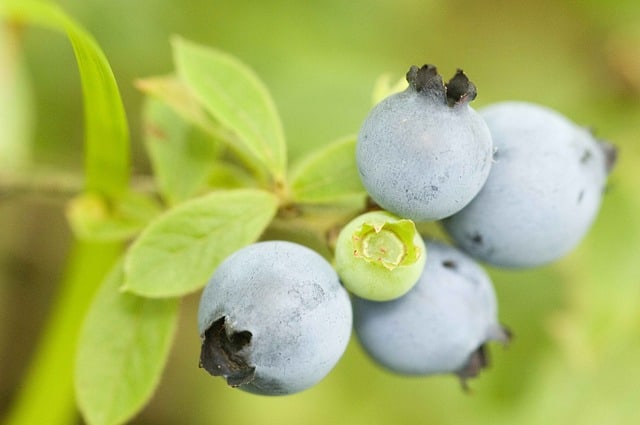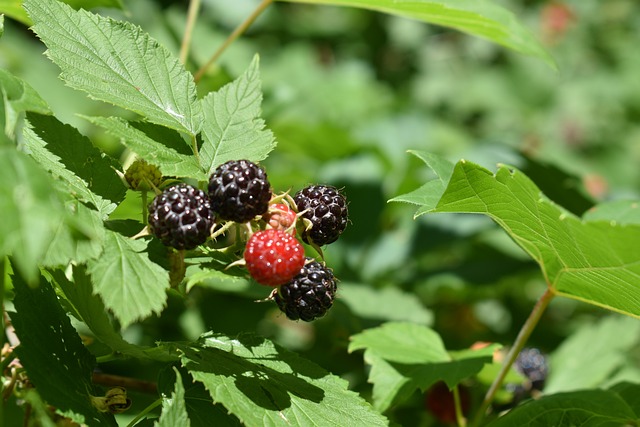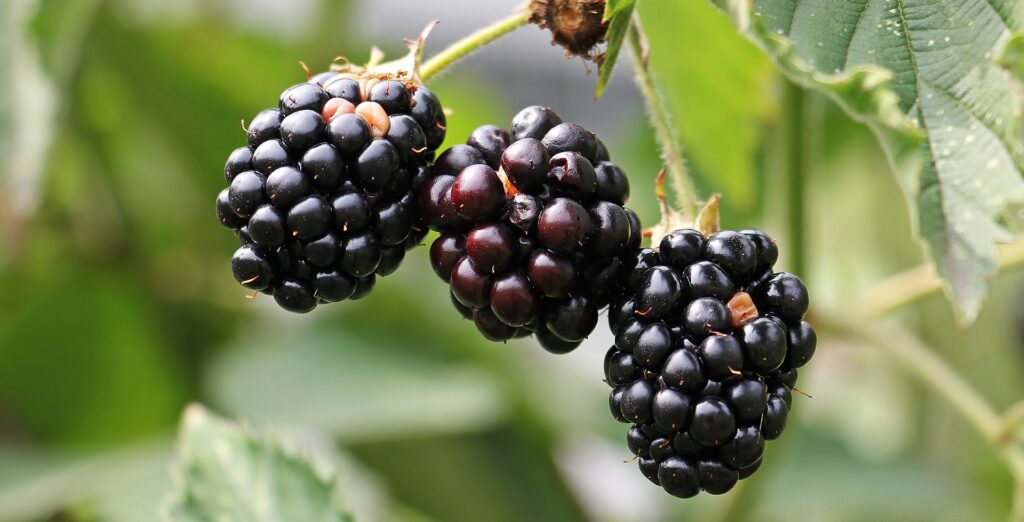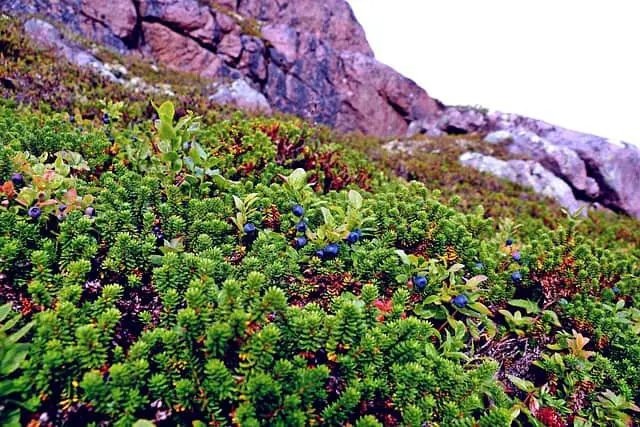Connecticut is a small state nestled in the heart of New England. Among the hidden treasures, there is a rich landscape teeming with wild berries waiting for an adventurous forager.
Foraging for wild berries not only connects us with the beauty of nature but also allows us to savor their delectable flavors and reap the health benefits they offer. In this blog post, we will delve into the world of wild berries in Connecticut, where to find them, and the different varieties you can look out for.
Let’s get straight into a Connecticut favorite: the wild blueberry.

Wild Blueberries In Connecticut
When it comes to foraging for the best berries in Connecticut, few experiences are as rewarding as the hunt for wild blueberries. These native gems offer a burst of flavor that sets them apart from their grocery store counterparts.
These native plants bear tiny white flowers before maturing into sweet and juicy blueberries. As early July arrives, the Connecticut landscape comes alive with small, low-growing wild blueberry plants. These blueberries are typically found until late August, though sometimes they can linger for a little longer.
However, if you’re used to grocery store blueberries, you may be looking right at the wild, lowbush variety and not even know it.
Understanding Wild Blueberries vs. Cultivated Highbush Blueberries
When we talk about wild blueberries, we’re talking about low-bush blueberries. Low-bush blueberries and high-bush blueberries belong to the same genus, Vaccinium. They differ significantly in taste, size, and growing habits. Unlike the larger, cultivated high bush blueberries found in supermarkets, wild blueberries are typically smaller in size, but they make up for it with an intensified flavor that is sweet, tangy, and often described as “wild.” Their complex taste profile adds an element of depth to culinary creations and makes them a sought-after treat for foragers.
They aren’t found everywhere in North America, so Connecticut is a fortunate place to have so many of them. Especially thanks to their health benefits.
Health Benefits of Wild Blueberries
Beyond their exceptional taste, wild blueberries are renowned for their numerous health benefits. Packed with powerful antioxidants, these tiny blue jewels can help protect the body against free radicals, reduce inflammation, and promote overall well-being. Wild blueberries are also rich in fiber, which aids in digestion, supports heart health, and helps maintain stable blood sugar levels. Additionally, they contain vitamins C and K, manganese, and other essential nutrients that contribute to a healthy immune system and strong bones.
Finding Wild Blueberries in Connecticut
Look for lowbush blueberries in sunny fields, open meadows, and even along the edges of forests. They thrive in well-drained, acidic soils, making sandy or rocky areas prime spots for foraging. While wild blueberries can be discovered in the wild, it’s worth noting that some farmers in Connecticut also cultivate these berries, allowing for a unique opportunity to visit their farms and experience the joy of picking wild blueberries firsthand. Taking advantage of the U-Pick farms in the state is a great opportunity to safely fill a bucket full of these sweet treats while also supporting local businesses.
When and How to Enjoy Wild Blueberries
Early July is typically the prime time to find ripe wild blueberries in Connecticut. Most people are generally going to wash them and eat them fresh. They are sweet, delicious, and oh so tempting. However, if you are of the mind to make them last, you can definitely freeze them to preserve them through the autumn and winter.
Wild, lowbush blueberries are enjoyed the same way highbush ones are. You can eat fresh blueberries alone or in your cereal or yogurt. Many people blend them into their smoothies. They’re also great for baking.
Other Types of Berries

Black Raspberries
Black raspberries are absolutely delicious. Their scientific name is Rubus occidentalis, but they’re also often referred to as thimbleberry. In the early spring, black raspberry plants will have white flowers, much like the wild blueberry. Then, in the late spring or early summer, these berries will emerge first as a red color, eventually ripening to black. They will only be ripe for two to three weeks, so when you find them, you need to pick them up quickly.
The black raspberries growing in the open sun will ripen sooner than the ones hidden in the shade. If you are someone who is foraging in areas frequently and marking where you find wild black raspberry plants, it would be a good idea to note where the sunny and shaded plants are. This way, you will know which ones to forage first.
These delectable berries grow on new canes of woody shrubs and can be found along forest edges, roadsides, or abandoned fields.
Keep in mind that the ones growing along roadsides may not be safe to eat. Raspberry and blackberry plants are often seen as a nuisance, so people may spray these plants with herbicides. When they grow along roadsides, they may also be exposed to an excessive amount of exhaust. You only want to eat wild raspberries that you’re sure are healthy and safe. Look for the ones in abandoned fields and at the edges of forests in safe areas where herbicides aren’t being used.
Black raspberries have a unique combination of sweetness and tartness, making them perfect for jams, pies, or enjoying fresh from the vine. They are a particularly great berry for turning into ice cream if you have the patience to freeze them and make your own ice cream. For many of us, these delicious berries just aren’t going to make it that far.

Wild Blackberries
Wild blackberries grow in acidic soils, like wild blueberries. Often, if you spot one of these plants in the Connecticut landscape, you may find the other nearby. As mentioned above, wild blueberries will ripen in mid-July. You may occasionally find wild blackberries blooming early in Connecticut, in which case you’ll need to have a basket ready as early as June. For the most part, though, you’ll find wild blackberries in July and August; around the same time, you’ll find lowbush blueberries.
On the topic of timing, it’s really best to wait to harvest wild blackberries until they are their signature black color. You want them to feel heavy, plump, and juicy. If they are red or purple, come back a few days later to check again.
As many of us know, wild blackberries grow on thorny canes. They love to sprawl out in sunny, open areas. To safely forage them, you’ll want to wear some gloves to protect your hands. It’s also a good idea to wear jeans to protect your legs since the plant does tend to move as you pull the berries free.

Red Raspberries
There are as many as five different species of raspberries growing wild in Connecticut. You’ll commonly see the black raspberry mentioned above. There is also the red raspberry with the scientific name Rubus idaeus var. strigosus. These bright red berries look a lot like the ones most of us are familiar with at the grocery store.
You may walk past red raspberries without noticing them, though. This is due to the fact that they grow very close to the ground, so you’ll need to keep your eyes open to spot them. You’ll often find them along the edges of forests or old fields. If you’re in a popular spot, the ones along the trail out in the open will be picked clean very quickly. These are popular berries with foragers. If you see the plants near the trail, wander a ways into the woods, and you may find more where the berries are still hanging out.
Start looking for wild red raspberries in the early summer, typically in July in Connecticut. By the middle of August, wildlife and other foragers will have picked most of them. You may also be able to find U-Pick farms in the area that have some available. Keep in mind that raspberries pull very easily off the plant so you’ll want to give them a gentle and quick tug, or you’ll risk bursting the berry.
Note that if you see white berries, leave them be. They’re not ripe yet, and they won’t have the sweet taste you’re looking for.
Red raspberries can be enjoyed fresh. If you have an excess amount of them, they are great frozen and added on top of ice cream or blended into smoothies. They also make a great jam.

Smooth Sumac
While not traditional berries, the small clusters of red fruit on the staghorn sumac (Rhus typhina) and smooth sumac (Rhus glabra) offer a delightful, tart taste that can be used to make refreshing beverages. These small trees or shrubs with feathery green leaves are abundant throughout Connecticut, particularly in open fields and roadsides. Simply steep the clusters in water to create a vibrant and tangy sumac lemonade.
You’ll want to be very specific when foraging for these. The sumac that produces white berries is poisonous. The sumac that produces red berries has edible berries. The leaves are still poisonous, though they do have medicinal properties when properly used. Native Americans in the area discovered these differences early on.
Due to the dangers of the poisonous white berries on the sumac and the dangers of the leaves, you’ll want to be very sure that you are correctly identifying these plants.

Rose Hips
The vibrant red or orange fruits of the rose family, rose hips, are visually appealing and a powerhouse of vitamin C. These nutritious berries are found in various Connecticut locations, including national forests and higher elevations. You’ll find them in the high-altitude meadows and riparian areas. Keep an eye out for wild rose bushes with their characteristic prickly stems and delicate pink or white flowers.
Rose hips are sometimes called rose berries. They can be enjoyed in the late fall. Sometimes, they hang on well into the early winter. Ensure you have the necessary tools, such as gloves and clippers, to harvest the rose hips carefully.
Rose hips are visually appealing and boast various health benefits and culinary possibilities. These tangy fruits are packed with immune-boosting vitamin C, powerful antioxidants, and other nutrients.

Elder Berry (sambucus nigra)
Elderberries are small, dark berries that grow on elder trees. There are many different kinds of elderberries, and the safety and flavor of each varies. They are native to Europe, Asia, and North America. Sometimes, the elder tree is a small tree, as the name suggests. Sometimes, they are deciduous shrubs.
Elderberry bushes and trees can grow up to 30 feet tall. They produce clusters of white flowers in the spring, followed by dark purple berries in the late summer and fall. Elderberries are rich in antioxidants, vitamins, and minerals and have been used for centuries in traditional Native American medicine to treat a variety of ailments, including colds, flu, and inflammation.
There is a lot of confusion and misinformation about whether elderberries are poisonous, with many people claiming that they are toxic and should be avoided. The truth is that elderberries contain a range of compounds, some of which can be harmful in large quantities. See
The elderberry leaves, stems, and unripe fruits of the elder tree (Sambucus nigra) contain cyanide-inducing glycosides. They can cause stomach issues like nausea, vomiting, and diarrhea if consumed in large quantities. If someone is experiencing these symptoms, they should immediately contact poison control and a medical professional.
Cautionary Note: Poisonous Berries and Lookalikes
While nature’s bounty offers an array of edible berries, it’s essential to exercise caution. Some plants, like poison ivy, produce white berries that are highly toxic and should be avoided at all costs.
Additionally, several plants, such as the bittersweet nightshade, Virginia creeper, and pokeweed, have berries that resemble edible varieties but are poisonous. The bittersweet nightshade can be deadly to pets, livestock, and small children. It will also make adults severely ill.
Ensure you properly identify the plants before consuming any berries.
Enjoy Your Connecticut Foraging Adventures
Foraging for wild berries in Connecticut provides a delightful and rewarding experience. From wild blueberries to red raspberries, the state offers an array of native species waiting to be discovered. Exploring the diverse landscape and reconnecting with nature through foraging not only provides a sustainable food source but also strengthens our immune systems by consuming the powerful antioxidants found in these wild treasures. So, grab a basket and embark on a berry-filled adventure through the scenic beauty of Connecticut.
Recent Posts
The only venomous snakes in Washington State are Northern Pacific Rattlesnakes. The Northern Pacific Rattlesnake (Crotalus oreganus oreganus) is a sub-species of the Western Rattlesnake. Anyone...
Skunks are not classified as true hibernators. But they go into a state of torpor when the weather gets cold. Skunks are light sleep hibernators, along with opossums, bears, and raccoons. ...

